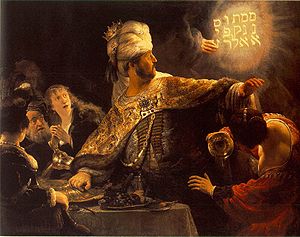.gif)
Belshazzar's Feast (Rembrandt)
Encyclopedia

Belshazzar
Belshazzar, or Balthazar , was a 6th century BC prince of Babylon, the son of Nabonidus and the last king of Babylon according to the Book of Daniel . Like his father, it is believed by many scholars that he was an Assyrian. In Daniel Belshazzar, or Balthazar , was a 6th century BC prince of...
and the writing on the wall
The writing on the wall
"The writing on the wall" , an idiom, is a portent of doom or misfortune. It originates in the Biblical book of Daniel—where supernatural writing foretells the demise of the Babylonian Empire...
in the Old Testament
Old Testament
The Old Testament, of which Christians hold different views, is a Christian term for the religious writings of ancient Israel held sacred and inspired by Christians which overlaps with the 24-book canon of the Masoretic Text of Judaism...
Book of Daniel
Book of Daniel
The Book of Daniel is a book in the Hebrew Bible. The book tells of how Daniel, and his Judean companions, were inducted into Babylon during Jewish exile, and how their positions elevated in the court of Nebuchadnezzar. The court tales span events that occur during the reigns of Nebuchadnezzar,...
. It is held in the The National Gallery, London.
The painting is an attempt to establish Rembrandt as a painter of large, baroque
Baroque
The Baroque is a period and the style that used exaggerated motion and clear, easily interpreted detail to produce drama, tension, exuberance, and grandeur in sculpture, painting, literature, dance, and music...
history paintings. The figures in Belshazzar's Feast are not attractive but they are shown realistically: Rembrandt has tried to capture the moment at which the banqueters stare, in amazement and terror, at the mysterious hand. The people have wrinkles and other blemishes which show that Rembrandt did not paint perfection. He liked the audience to see the eyes of the figures to reinforce the mood of the painting. This is apparent if the audience looks closely in Belshazzar's Feast at the central figure of the King of Babylon and the queen sitting next to him. They have a look of surprise and the detail around the eyes reinforces this notion.
The mood of the painting is alarm and surprise. This is shown through Rembrandt's distinctive manipulation of light and shadow by means of altering the texture, potency, direction of stroke subtly achieve the desired mood. This is called Chiaroscuro
Chiaroscuro
Chiaroscuro in art is "an Italian term which literally means 'light-dark'. In paintings the description refers to clear tonal contrasts which are often used to suggest the volume and modelling of the subjects depicted"....
. Light and shadows play a significant role in developing the mood of Belshazzar's Feast especially around the hand that writes on the wall and the reflection of King Belshazzar's royal cloak. The shadows are used to hide the unnecessary or distracting details and light is used to illuminate the faces of the figures.
The materials used for Belshazzar's Feast were oil on canvas and this allowed Rembrandt to manipulate the paint to create defined shadows, light, atmosphere, motion and mood. Signs and symbols are used to subtly convey the morals and biblical message across to the audience. The hand that is writing the message on the wall is male. This clearly represents the Almighty God. The vessel that has been tipped over is a Holy Communion cup which represents the blasphemy that took place at the feast. The gold which is reflecting off the royal cloak that the king is wearing epitomizes the wealth of the Kingdom of Babylon.
The composition of this artwork shows evidence of planned organisation. This is apparent in the placement of the figures and the use of light so that the eye of the audience is drawn towards the writing on the wall then the central figure of King Belshazzar. The light illuminating from the writing on the wall seems to reflect off the eyes of the figures, the king's cloak and the vessels. Observers in the painting are shown in varying degrees and facing different direction yet looking at the same point in the top right hand corner. Rembrandt emphasized the dramatic posture of King Belshazzar.
The aesthetic principals are a significant component of this art work. The texture on the faces of the figures is used to make the scene more realistic. Warm vibrant colours and the use of diaphanous light are also used to create a life like effect. These aesthetic principals distinguish Rembrandt art work
Rembrandt lived in the Jewish Quarter of Amsterdam and "derived the form of Hebrew inscription from a book by his friend, the learned Rabbi and printer, Menasseh ben Israel, yet mistranscribed one of the characters and arranged them in columns, rather than right to left, as Hebrew is written." This last detail may be a reference to a Jewish tradition that the words were unintelligible to any but Daniel because they were written vertically. (Other explantions have also been offered as to why the Babylonians were unable to read words in their own language.)

